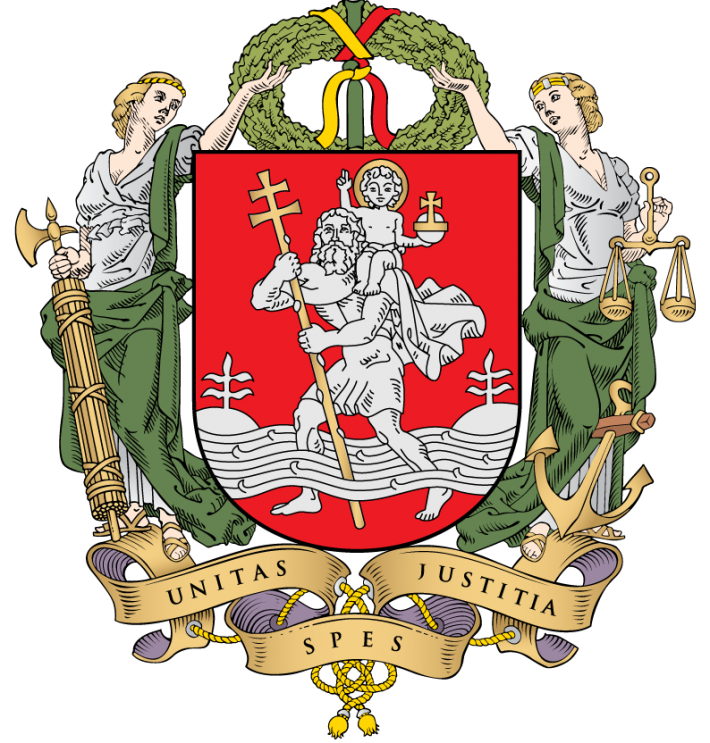Views: 182
 In Old Town in Vilnius, at the Church of the Holy Spirit, on St. Ignatius St., a Dominican monastery was established in 1501
In Old Town in Vilnius, at the Church of the Holy Spirit, on St. Ignatius St., a Dominican monastery was established in 1501
 At the time of Napoleonic Wars (in 1812) the Dominican monastery of the Church of the Holy Spirit was used by the French army as a hospital
At the time of Napoleonic Wars (in 1812) the Dominican monastery of the Church of the Holy Spirit was used by the French army as a hospital
 The monastery was converted into a prison by the Russian authorities in 1807. Corridors are decorated by frescoes from the 18th century
The monastery was converted into a prison by the Russian authorities in 1807. Corridors are decorated by frescoes from the 18th century
All photos are copyrighted by Vladislav B. Sotirovic
© Vladislav B. Sotirovic 2021
RELATED POSTS
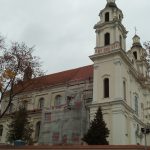
The church is an elegant late Baroque monument built-in 1702-1730. It is made even more attractive by an asymmetrical monastery ensemble in 1713-1730The towers date from the mid-18th century. They end in rococo domes with lanterns Both the church and the monastery belonged to the Jesuit Order. The monastery was intended for the Jesuit monks with 10 years of service experience seeking to become professed Jesiuts, i.e., to make the last ceremonial vowes All photos are copyrighted by Vladislav B. Sotirovic© Vladislav B. Sotirovic 2019
Continue Reading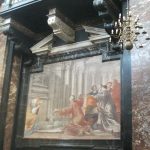
The silver cofin of St. Casimir is under a plaster canopy accompanied by relics. Under the cofin is a miraculous painting in a silver frame, with a silver statue with the saint's attributes placed on the cofin. The relief features a very rare depiction of a smiling Blessed Virgin Mary with Baby JesusIn the chapel there are eight silver-plated wooden Baroque statues of the Kings and Grand Dukes of Poland and Lithuania from the Gediminid and Jagiellon dynasties from the 17th centuryThree-Handed Image of St. Casimir c. 1520. This painting is considered to be miraculous. In 1743 the painting was put into a silver, gold-plated framing. St. Casimir is holding lilies and a rosary, which are his symbolsAll photos are copyrighted by Vladislav B. Sotirovic© Vladislav B. Sotirovic 2020
Continue Reading
One house in Augustijonų Street in Vilnius Old Town. Behind the house is the Church of Our Lady, Comfort of the AfflictedA view from Augustijonų Street on the top of the tower of the Church of Our Lady, Comfort of the Afflicted. This church used to be known for its lavish decoration, but the altars, pulpit, and organ were removed in 1852 when it was transformed into a Russian Orthodox Church One courtyard in Augustijonų Street in front of the Church of Our Lady, Comfort of the AfflictedAll photos are copyrighted by Vladislav B. Sotirovic© Vladislav B. Sotirovic 2019
Continue Reading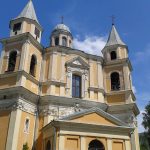
The interior sculptural décor was created by Pietro Perti (Italian master) in 1700-1705. Twin towers were built on in the 18th century. It was built by the efforts of Casimir Sapieha the Younger (1637-1720) in 1694-1717 On the façade frieze two Christian soldiers taken into captivity by the Muslims are represented. The main goal of the Trinitarian Order was returning such captives to their homelands The church has an impressive cupola (dome), the interior is adorned with stucco relief works and sculptures - a large part of them is survived. The church is a "sister" to the Church of St. Peter and St Paul in Vilnius (Antakalnis)All photos are copyrighted by Vladislav B. Sotirovic© Vladislav B. Sotirovic 2019
Continue Reading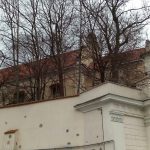
The church was originally Gothic but in 1750-1755 it was restored according to design by Franz Ignatius Hoffer and acquired some late Baroque and Rococo featuresNearby the church building stand the 17th-18th-century buildings of the Carmelite Monastery which had a rich archive and library. A study centre opereted there. In 1797-1944 it housed the Ecclesiastical Seminary Today the buildings are used by the Centre for Book Research and Libraries, and the church is closed to the publicAll photos are copyrighted by Vladislav B. Sotirovic© Vladislav B. Sotirovic 2020
Continue Reading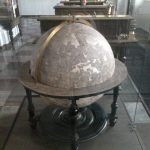
Vilnius University was the first observatory center in Eastern Europe and the 4th in the worldWhite Hall now houses unique astronomical instruments and a reading roomThe narrow staircase leads to the observatory tower, which reveals a panorama of the Vilnius Old TownAll photos are copyrighted by Vladislav B. Sotirovic© Vladislav B. Sotirovic 2023
Continue Reading
S. Skapo Street marks the northern limit (right) of the Vilnius University Old CampusA nice perspective view of de Reuss Palace seen from S. Skapo Street (west side) The Lopaciński or Sulistrowski estate in S. Skapo Street. The building got its Classical style according to Martin Knackfuss project. In 1930, the west wing was refurbished as the bishop's house. From 1940, the building housed a music schoolAll photos are copyrighted by Vladislav B. Sotirovic© Vladislav B. Sotirovic 2020
Continue Reading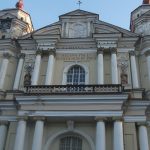
The founder of the church was a Grand Hetman and Vilnius Voivode of the Grand Duchy of Lithuania. The 17th-century church's façade is modest, however the interior is richly ornate with a number of stucco mouldings The church was built to mark the liberation of Vilnius from Moscow (The 1655-1661 War) and the founder's own escape from the hands of rebellious soldiers. The interior was created by the Italians G. P. Perti and G. M. Galli, who decorated it with more than 2,000 stucco mouldings The chandelier was created in 1905 in Riga and represents the Biblical Noah's arkAll photos are copyrighted by Vladislav B. Sotirovic© Vladislav B. Sotirovic 2018
Continue Reading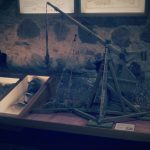
Althought it appears quite large from the outside, the thikness of the tower's walls make it a relatively small exibition space. Its floors hold various items of weaponry and engravings, and models which give an idea of how the site looked and was used in earlier timesThere are models of the three castles from the 14th and early 17th century. They provide an interesting comparison, to show how the site developedThe focal attraction of the museum is the view from the roof, and a narrow staircase leads visitors up to a parapet that overlooks the entire center of the city. This is the best place from which to appreciate the variety of colours of the Old TownAll photos are copyrighted by Vladislav B. Sotirovic© Vladislav B. Sotirovic 2020
Continue Reading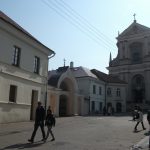
It was built from 1633 to 1654 under the patronage of the Vice-Chancellor of the Grand Duchy of Lithuania, Stephen Pac. Most probably the exterior was designed by Italian Constantino Tencalla. The exterior of the Church of St. Theresa is designed according to the models of Roman architecture: it is noble and harmonious, built along with the vertical principle with volutes and side obelisksThe St. Theresa Church (left) is located at Dawn St. nearby the Gate of Dawn (at the top) that is famous for its miraculous image of the Mother of Mercy (or Mary of Vilnius)The chapel is built by the Barefoot Carmelite monks for the miraculous picture of Mary of Vilnius in 1671. The St. Theresa Church was built with a large Barefoot Carmelite Monastery, established near Vilnius' defensive wall All photos are copyrighted by Vladislav B. Sotirovic© Vladislav B. Sotirovic 2018
Continue Reading
The church is inconspicuous from the street, as its façade does not face the streetThe 51 meter-tall dome can be seen from seven Old Town streetsThe Dominican Church of the Holy Spirit is one of the most magnificent churches in Vilnius. It is an excellent monument of high and late Baroque All photos are copyrighted by Vladislav B. Sotirovic© Vladislav B. Sotirovic 2018
Continue Reading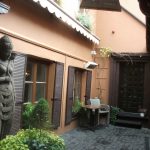
The building of Vilnius Gymnasium of Vytautas the Great - the first gymnasium in Lithuanian language est. in Vilnius at the beginning of the 20th centuryThe backside of the Church of Our Lady, Comfort of the Afflicted seen from Augustijonų Street in Vilnius Old Town. In Soviet times the church was used as a warehouse, and in 1967 the interior was divided into several shops by the construction of concrete floors. The building is today in urgent need of restorationThe entrance to the Jesuit Gymnasium in Augustijonų Street in Vilnius Old Town. Behind the gymnasium is St. Casimir ChurchAll photos are copyrighted by Vladislav B. Sotirovic© Vladislav B. Sotirovic 2019
Continue Reading
The Jewish Str. in Vilnius was known as hosted the Great Synagogue of Vilnius, the Jewish (Strashun) Library of Vilnius, the Schulhoyf yard, the Gaon House and the Gaon Synagogue among other buildings Gaon Str. with the Stikliai (Glass) Hotel on the corner of the Glass Square where the glass products have been sold since the mid-16th centuryAt the entrance to Gaon Str. in 1941 it was the gate to the Small Jewish Ghetto which existed from September 6th to October 29, 1941. The Small Jewish Ghetto had around 11.000 inhabitantsAll photos are copyrighted by Vladislav B. Sotirovic© Vladislav B. Sotirovic 2019
Continue Reading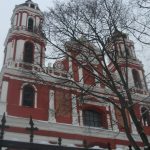
The church was built on the north side of the Lukiškių Square in 1624. However, the present building dates from the late 17th-18th cent.It is a single-nave Baroque church with cylindrical vaults. An image of the miraculous painting of the 18th century high altar occupies the niche above the porticoThe niches hold wooden 18th cent. statues of St. Hyacinth and St. Dominic. During the Soviet times there were designs to demolish the church but it did not ever happenAll photos are copyrighted by Vladislav B. Sotirovic© Vladislav B. Sotirovic 2018
Continue Reading
Wonderful panoramic view can be seen from the roof (platform) of Gediminas Tower (Upper Castle Tower)Despite wars and destructions, the architectural ensemble of Vilnius Old Town remains unique. Baroque domes and towers of Vilnius Old Town coexist with an irregular medieval city plan Vilnius Old Town is lacking German or Scandinavian features, rather reminiscent of Prague or Rome, Vilnius differs greatly from the other Baltic capitalsAll photos are copyrighted by Vladislav B. Sotirovic© Vladislav B. Sotirovic 2019
Continue Reading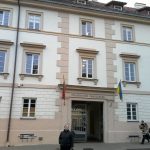
Hostel Courtyard of the Old Campus of the Vilnius UniversityIn the late 19th century all houses of the courtyard were reconstructed and in the early 21st century water supply and sewerage systems were installed. Apartments were rented in those housesInterior of the present-day Faculty of Philosophy. After the reconstruction was completed in the spring of 2005, the Faculty of Philosophy was relocated hereAll photos are copyrighted by Vladislav B. Sotirovic© Vladislav B. Sotirovic 2023
Continue Reading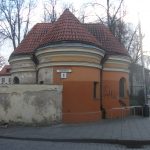
The small garden between the church and the street used to be a cemetery. It is still occupied by a mausoleum built in 1708 for the Suzin's familyThe Suzin's family chapel was functioning as a souvenir shop during the Soviet administration The Suzin's family mausoleum chapel is located on the corner of Trakų St. and Franciscan St. in the Old Town in VilniusAll photos are copyrighted by Vladislav B. Sotirovic© Vladislav B. Sotirovic 2020
Continue Reading
The Church of the Heart of Jesus is a significant monument of Baroque (finished in 1756). It is the only Roman Catholic church in Lithuania to be built along a Greek Orthodox cross designThe church has a large octagonal cupola (dome) and a very reach the elegant exterior. The interior is no less magnificent, although it was severely damaged during the Soviet timeAfter 1945, a prison was established in the church and convent buildings. The church interior and the plan of the convent buildings were transformed. After 1990, the sacral buildings are returned to their former ownersAll photos are copyrighted by Vladislav B. Sotirovic© Vladislav B. Sotirovic 2020
Continue Reading
This short (250 m), narrow and crooked street with Baroque and Classical houses is surrounded by curving, walls, ancient façades and typical 17th and 18th-century courtyardsIn Bernardinų St. in the house No. 11 a famous Polish-Lithuanian poet Adam Mickiewicz lived in April-June 1822. His apartment is located on the left side of the ground floor which is today transformed into the museumBernardinų St. connects the ensemble of the Churches of St. Anne and Bernardines with Pilies St. In 16th century, it was a section of a road connecting the complex of royal castles with the Bernardinų Gate of the cuty defensive wall All photos are copyrighted by Vladislav B. Sotirovic© Vladislav B. Sotirovic 2020
Continue Reading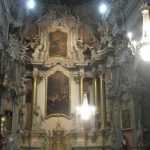
The interior od the church is in the Rococo style with the exception of the Pac Chapel, which is late Baroque in the exterior, and rather Classical in the interior Impressive, gently-curved church pulpit in the Rococo style is created from wood and gold-plated tin in the second half of the 18th centuryThe church's mural painting is the only one of its size remaining in Lithuania. One arch depicts 19 scenes from St. Theresa's lifeAll photos are copyrighted by Vladislav B. Sotirovic© Vladislav B. Sotirovic 2020
Continue ReadingChurch of St. Archangel Raphael
Chapel of St. Casimir (interior)
Augustijonų Street (I)
Church of Our Lord Jesus and the Trinitarian Monastery
The Church of St. George the Martyr
Astronomic Instruments at the White Hall at Vilnius University
S. Skapo Street
Church of St. Peter and St. Paul in Vilnius
Vilnius Castle Museum (Western Tower of the Upper Castle)
Church of St. Theresa and the Monastery of the Barefoot Carmelites
Church of the Holy Spirit & Former Dominican Monastery (Exterior)
Augustijonų Street (II)
The Jewish Street and Gaon Street in the Old Town of Vilnius
Church of St. Jacob and Philip (1)
Vilnius Old Town Panoramic View
Bursa (Student Dormitory) Courtyard at Vilnius University’s Old Campus
The Suzin’s Family Mausoleum Chapel
Church of the Heart of Jesus and the Convent of the Visitationists in Vilnius
Bernardinų Street in Vilnius
Church of St. Theresa (Interior)



